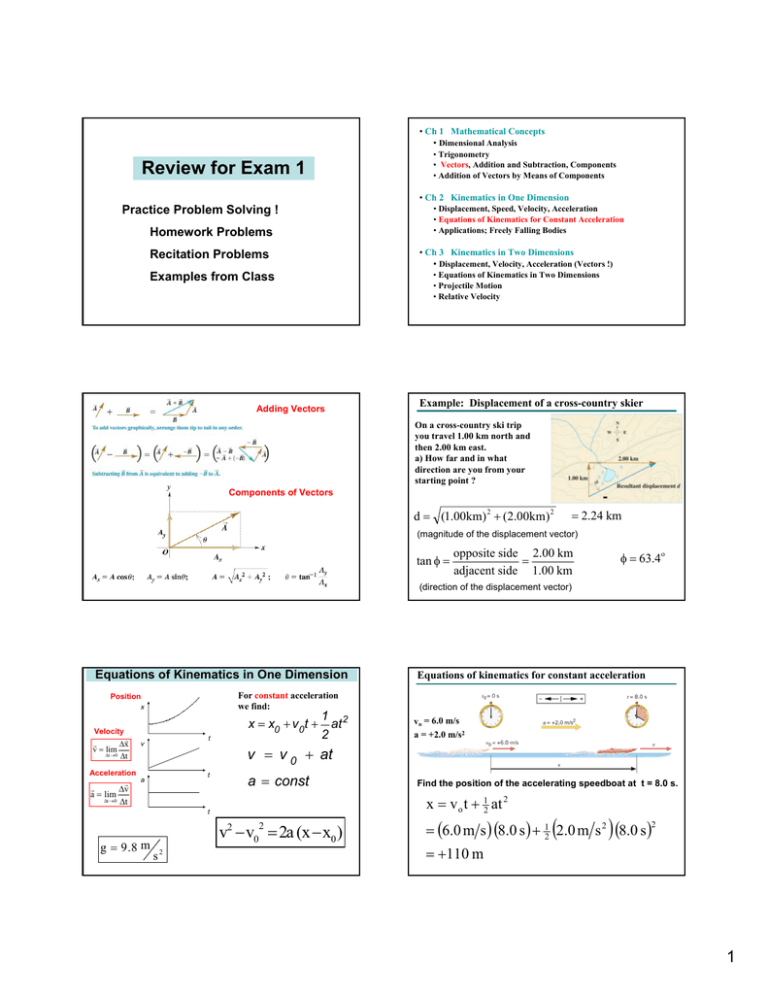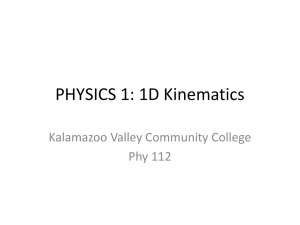Review for Exam 1
advertisement

• Ch 1 Mathematical Concepts • Dimensional Analysis Review for Exam 1 • Trigonometry • Vectors, Addition and Subtraction, Components • Addition of Vectors by Means of Components • Ch 2 Kinematics in One Dimension Practice Problem Solving ! Homework Problems Recitation Problems Examples from Class Adding Vectors • Displacement, Speed, Velocity, Acceleration • Equations of Kinematics for Constant Acceleration • Applications; Freely Falling Bodies • Ch 3 Kinematics in Two Dimensions • Displacement, Velocity, Acceleration (Vectors !) • Equations of Kinematics in Two Dimensions • Projectile Motion • Relative Velocity Example: Displacement of a cross-country skier On a cross-country ski trip you travel 1.00 km north and then 2.00 km east. a) How far and in what direction are you from your starting point ? Components of Vectors d = (1.00km) 2 + (2.00km) 2 = 2.24 km (magnitude of the displacement vector) tan φ = opposite side 2.00 km = adjacent side 1.00 km φ = 63.4o (direction of the displacement vector) Equations of Kinematics in One Dimension For constant acceleration we find: Position x Velocity r r Δx v = lim Δt →0 Δt t v 1 x = x0 + v0t + at 2 2 t a a = const v2 − v0 = 2a (x − x0 ) 2 s2 Find the position of the accelerating speedboat at t = 8.0 s. x = v o t + 12 at 2 t g = 9 .8 m vo = 6.0 m/s a = +2.0 m/s2 v = v 0 + at Acceleration r r Δv a = lim Δt →0 Δt Equations of kinematics for constant acceleration ( ) = (6.0 m s ) (8.0 s ) + 12 2.0 m s 2 (8.0 s ) 2 = +110 m 1 Velocity in two dimensions Definition of average velocity v av = Acceleration in two dimensions r2 − r1 Δ r = t 2 − t 1 Δt Definition of average acceleration a av = Definition of instantaneous velocity v = lim Δr Δt v 2 − v1 Δ v = t 2 − t1 Δt Definition of instantaneous acceleration a = lim Most important concept in two-dimensional motion • two-dimensional motion can be decomposed into motion in x-direction and motion in y-direction “x” and “y” components of motion are independent Constant-Acceleration Equations of Motion in Two-Dimensions vx = v0x + axt x = x0 + v0xt + (½ )ax t2 • Person on a cart throws ball vertically upwards – Seen from two different frames of reference Reference frame on moving cart Equations for Projectile Motion (assuming that ax = 0, ay = -g) vx = v0x x = x0 + v0xt (1) (2) vy = v0y + ayt y = y0 + v0yt + (½ )ay t2 vy = v0y – gt (3) 2 y = y0 + v0yt - (½ )gt (4) v2x − v0x = 2a x (x − x0 ) v2y −v0y = −2g (y− y0) 2 Reference frame on the ground Δv Δt v2y − v0y = 2ay (y − y0 ) 2 2 Example: A moving spacecraft Example: The height of a kickoff A placekicker kicks a football at and angle of 40.0 degrees and the initial speed of the ball is 22 m/s. Ignoring air resistance, determine the maximum height that the ball attains. v= v θ v x = 190 m s (190 m s ) + (98 m s ) 2 2 = 210 m s v y = 98 m s θ = tan −1 (98 190 ) = 27 o vo θ v ox = v o cos θ = (22 m s ) cos 40 o = 17 m s v oy Voy = Vo sin θ = (22m / s )(sin 40°) = 14 m / s v ox 2 Relative velocity in 2-dim The concept of relative velocity can be extended from 1-dim to 2-dim y ? ay -9.80 m/s2 vy voy 0 14 m/s 2 v 2y = v oy + 2a y y 0 − (14 m s ) y= = +10 m 2 − 9 .8 m s 2 2 ( ) y= t 2 v 2y − v oy 2a y Velocities can carry multiple values depending on the position and motion of the object and observer 3




